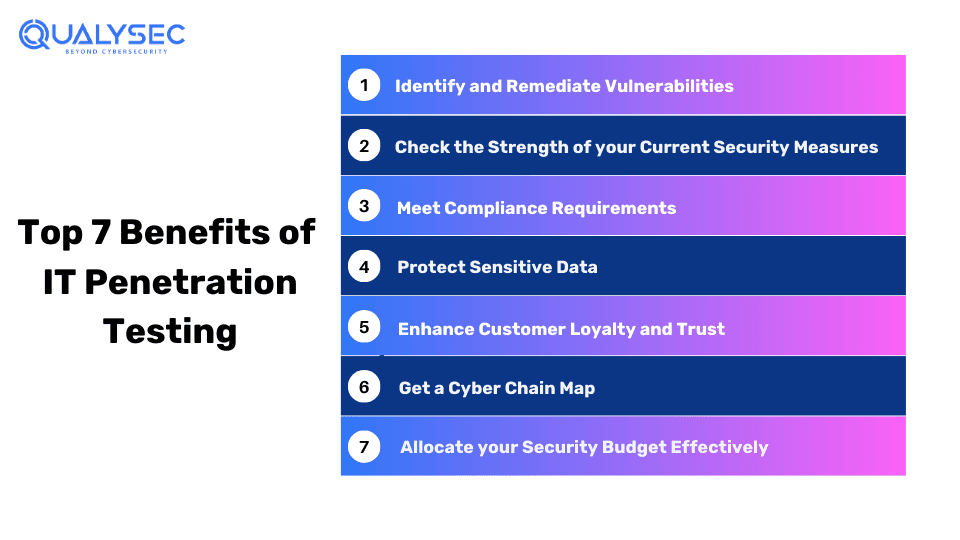IT penetration testing – a security exercise where cybersecurity experts or ethical hackers test your digital assets, including applications, networks, cloud, etc. for potential vulnerabilities.
Cybercrimes happen way more often than you think. As per a recent study by The University of Maryland, on average, there are 2,244 cyberattacks each day. This means there’s about one attack every 36 seconds. If you are not serious about cyber security, you should be, because there is a high chance you might be the next victim.
Fortunately, there are ways through which you can prevent cyber threats from harming your business.
In this blog, you will get to know about penetration testing, its various benefits, and its different types. Check out the entire blog if you want to secure your business digitally.
Definition of IT Penetration Testing
As data breaches and cyberattacks grow, the need for penetration testing increases. But what exactly is penetration testing and what is its purpose?
Penetration testing or pen testing is a manual security testing process where ethical hackers test the given environment to find security flaws that real hackers could exploit. Before hackers attack an organization, they employ cyber security companies to assess the strength of their security measures to find and fix faults.
Pen testers are certified in offensive exploitation, and everything is done under the approval of the organization. IT penetration testing is when the organization tests each of its IT infrastructures, including networks, clouds, web applications, mobile applications, and more.
Purpose of IT Penetration Testing
Simply put, the main purpose of IT penetration testing is to find vulnerabilities in IT infrastructure and assess their level of risk.
IT companies invest heavily in their development of digital infrastructure. However, they often struggle to implement the necessary steps to secure and protect their assets after deployment. Once an attack occurs on their applications or networks, they react immediately with a response team to review their system – rather than approaching proactively with penetration testing.
When they say, prevention is better than cure, it applies to cybersecurity too. Usually, the cost to fix the systems after a cyberattack is much more than the cost of conducting security testing. With regular pen tests, you can not only protect your IT infrastructure but also increase your reputation among customers.
“Secure your IT infrastructure from cyber threats today! Drop us an mail and we will contact you ASAP!”
7 Benefits of IT Penetration Testing
Up until now you already know that IT penetration testing helps find vulnerabilities in various digital structures. Yet, we want you to know all the benefits of conducting penetration tests. With that in mind, here are 7 top benefits of conducting regular IT penetration testing:

1. Identify and Remediate Vulnerabilities
As discussed above, the main benefit of IT penetration testing is to identify potential vulnerabilities, determine their risk level, and remediate them.
Trained ethical hackers test your systems to detect security gaps that you may never realize existed. With pentesting, businesses will be able to find potential weak points in the systems that cybercriminals could use to infiltrate.
It is also a crucial part of the software development life cycle (SDLC). By testing the application or software before it is launched, you can prevent potential issues, bugs, and errors from affecting users and ensure a smoother and more reliable user experience.
2. Check the Strength of your Current Security Measures
Another advantage of IT penetration testing is to check how strong are your defenses and how resilient your security measures are against a cyberattack.
With the identified vulnerabilities, you can know where your defense is the strongest and where it is weak. As a result, you can prioritize those areas and allocate your resources accordingly to improve them.
For example, if your network has several vulnerabilities like outdated software and weak authentication methods, the IT team can prioritize patching those vulnerabilities and implementing stronger access controls.
3. Meet Compliance Requirements
IT penetration testing benefits organizations by ensuring compliance with industry regulations. Many industries have made it mandatory for organizations to conduct security testing in order to protect public information.
Not complying with these regulations will result in fines and legal penalties. As a result, with penetration testing, organizations can fulfill these requirements with ease and prevent embarrassment in their respective industries.
Common industry standards include:
-
- HIPAA
- PCI DSS
- SOC 2
- GDPR
- ISO 27001
4. Protect Sensitive Data
Data is gold in the IT industry. If you are not keeping your company and customer data secure, you are risking a severe breach and data theft.
IT penetration testing helps discover potential security gaps that hackers exploit to gain unauthorized access to sensitive information. For example, customer records, financial information, and intellectual property. If any data is left unprotected, a pentest will let you know about it.
You can then make changes based on the pentest result, to improve your security measures. Additionally, keeping sensitive data safe can help you with compliance and market reputation.
5. Enhance Customer Loyalty and Trust
With new hacks and data breaches happening every day, clients and customers are always worried about their confidential information.
If the results of your penetration tests are positive, you can share them with the world. Otherwise, if they are negative, you can make necessary fixes and then share them once they are resolved. As a result, it will show your commitment to security and prioritizing customer data.
This is an excellent way to build trust between you and your customers. They will feel that you are handling your systems and their information securely. They’ll also feel safer while working with you or using your services. This can therefore increase customer loyalty and also help you attain more customers
Penetration tests are all about providing evidence that you prioritize security. It shows that you’re fixing issues regularly and working very hard to provide the best service possible for your customers.
6. Get a Cyber Chain Map
As a penetration test simulates real cyberattacks, you can see the direction a real hacker might go through in different systems. This is commonly referred to as lateral movement. When a hacker infiltrates your application, most of the time they go deeper to find the most secure data.
When you conduct a penetration test, you can map a full route through your system’s security. As a result, you can see which defenses are working and which aren’t.
It also means you can have a full map of how certain connections are made between different layers within your system. This is a great insight when you plan improvements and optimizations in the future.
7. Allocate your Security Budget Effectively
After a successful penetration test, you will know which areas need fixing. Additionally, it will let you know which areas need more fixing and which need less fixing. As a result, you can allocate your resources and finances appropriately.
The penetration testing report will help you make informed decisions with security measures. For example, you might want to spend more on critical risks that have a high impact rather than on minor risks that can be neglected.
By prioritizing security measures based on the findings of penetration tests, organizations can optimize their budget constraints and secure their most valuable assets from potential breaches and attacks.
Want to see a real IT penetration testing report? Click the link below and download one now and get an idea of what can you expect from it!
Latest Penetration Testing Report

Different Types of IT Penetration Testing
There are mainly 5 types of IT penetration testing that organizations can choose as per their business needs.
1. Application Penetration Testing
Application penetration testing involves assessing the security of software applications, including web apps and mobile apps, to identify vulnerabilities and potential weaknesses. As a result, it can improve application security, reduce the risk of breaches, and enhance the protection of sensitive data.
2. Website Penetration Testing
Website penetration testing focuses on checking the security of websites to find security gaps that hackers could exploit. Therefore, it strengthens the website security, improves protection against cyberattacks, and increases customer trust.
3. Network Penetration Testing
Network penetration testing evaluates the security of the network infrastructure to find weak points for attacks. It benefits businesses by strengthening their network security. Additionally, it reduces the risk of unauthorized access and enhances resilience against cyber threats.
4. API Penetration Testing
API penetration testing analyses the security of application programming interfaces (APIs) to identify potential risks associated with data exchange. As a result, it enhances data protection and reduces API-related breaches.
5. Cloud Penetration Testing
Cloud penetration testing is the process of reviewing the security of cloud-based systems and services to identify potential risks and vulnerabilities. Hence, organizations can enhance their overall cloud security, improve data protection measures, and comply with industry regulations.
Conclusion
With the rise of data breaches and cybercrimes, the need for cybersecurity is now all-time high. The best way to protect your digital assets is by performing IT penetration testing. Be it for compliance needs, client demands, or just a desire to have a secure IT infrastructure, penetration testing is the best way to avoid getting hacked.
As IT penetration testing is done by a third-party cybersecurity company, you will have a fresh perspective on where the fault lies. Additionally, they may recognize things that you and your team have not, which will benefit you in the long run. So, do you want to secure your IT infrastructure? The answer lies with penetration testing!
Want to protect your business from cyber threats? Schedule a comprehensive IT penetration test today with us and ensure the security of your digital assets. Don’t wait until it’s too late – safeguard your organization with our expert testing services now!
Talk to our Cybersecurity Expert to discuss your specific needs and how we can help your business.
FAQs
Q: What is penetration testing in IT?
A: Penetration testing (or pen testing) in IT is a security exercise where cyber-security experts or ethical hackers attempt to find and exploit vulnerabilities in IT systems like applications, networks, etc. It is done to fix the security flaws that lie in the IT infrastructure.
Q: What is the goal of IT penetration testing?
A: The primary goal of IT penetration testing is to determine vulnerabilities present in an IT infrastructure and their risk level. It aims to enhance the overall security posture, meet compliance needs, and maintain trust and reputation.
Q: What are the steps of penetration testing?
A: The 7 basic steps of penetration testing include:
-
- Information gathering
- Planning
- Automated vulnerability scans
- Manual penetration testing
- Reporting
- Remediation
- Retesting
- LOA and security certificate
Q: Is penetration testing a QA?
A: No, penetration testing is not quality assurance (QA). QA is a process-orient testing that mainly focuses on finding and preventing errors in the development process. Penetration testing is a security-oriented process to identify vulnerabilities present in different digital assets such as applications, networks, APIs, etc.




































































































































































































































































































































































































































































































































0 Comments